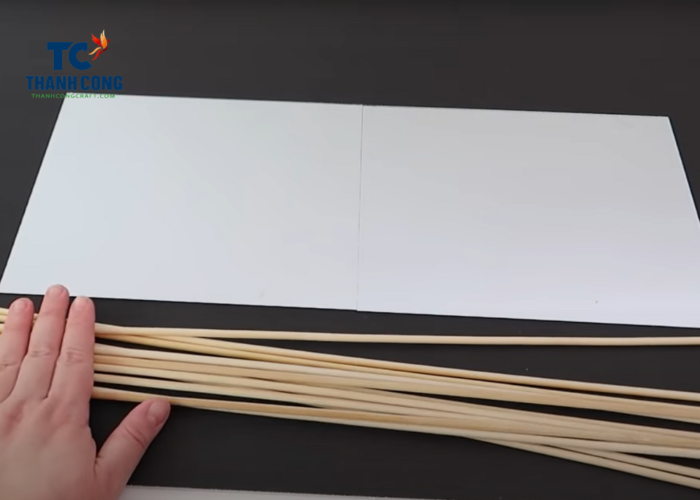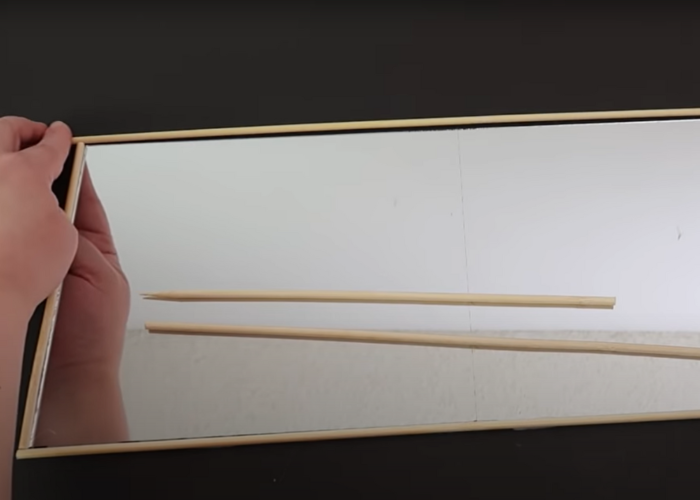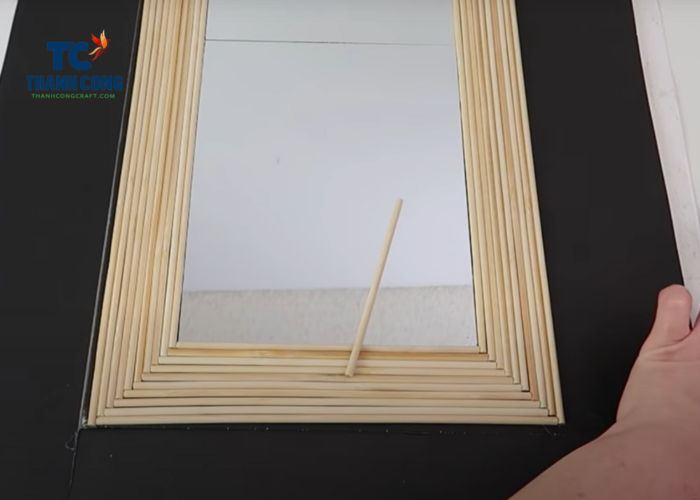Bamboo is a type of plant that has many applications in life, from agriculture, construction to decoration. One of the ways to use bamboo to create unique and environmentally friendly products is to make mirror frames. In this article, we will guide you how to make a bamboo mirror frame diy with bamboo sticks by an easy way.
1. How to make a bamboo mirror frame?
DIY a bamboo mirror frame is a wonderful way to infuse natural beauty into your living space while adding a touch of craftsmanship to your decor.
Gathering materials
You will need the following materials: a round mirror, some bamboo sticks, a pair of scissors, a knife, a roll of rope, a roll of tape, a hot glue gun and some wall hooks. You also need a spacious area to work.
Step-by-Step Instructions
Step 1: Cut the bamboo sticks
You need to cut the bamboo sticks into segments with the length equal to the radius of the mirror. You can use the knife to scrape off the outer shells of the bamboo sticks to make them smoother. You should cut about 20 to 30 bamboo segments to create the frame for the mirror.

Step 2: Glue the bamboo sticks to the mirror
You use the hot glue gun to glue the bamboo segments to the back of the mirror. You should glue them in a star shape, so that the ends of the bamboo sticks are evenly spaced and create gaps between them. You should glue the bamboo segments firmly so that the mirror frame does not wobble.

Step 3: Wrap the rope around the mirror frame
You use the rope to wrap around the bamboo segments, so that it covers the glue points. You should wrap from inside to outside, so that the rope covers the entire mirror frame. You can use tape to fix the rope when wrapping.

Step 4: Hang the mirror on the wall
You use wall hooks to hang the mirror on the desired position. You should choose a position with good lighting and suitable for the style of the room. You have completed making a simple and beautiful bamboo mirror frame.
2. FAQs
2.1 Should a mirror have a frame?
The decision on whether a mirror should have a frame depends on individual taste, the style of the space, and the desired functionality of the mirror. Some benefits of having a frame for the mirror are:
- -The frame can protect the edge of the mirror from scratches, cracks or stains.
- The frame can enhance the aesthetic appeal of the mirror and the surrounding space, by creating a focal point or coordinating with other furniture pieces.
- The frame can help adjust the light and reflection in the room, by choosing the appropriate color and material.
However, it is not always necessary or desirable to have a frame for the mirror. Some cases where you may not want to have a frame are:
- You want to maximize the area of the mirror, especially if your space is small or narrow. You want to create a sense of spaciousness and airiness for the room, by using a frameless mirror to enhance the illusion effect.
- You want to save costs or installation time, as frameless mirrors are usually cheaper and easier to hang on the wall.
2.2 How do you attach a mirror to a frame?
To affix a mirror to a frame, gather essential tools such as double-sided tape, a hammer, nails, a ruler, and a pencil. Follow these steps for a seamless attachment:
- Measure: Determine the appropriate position for attaching the mirror by measuring both the mirror and the frame. This ensures accurate placement.
- Apply Double-Sided Tape: Place double-sided tape on the back of the mirror, maintaining even spacing from the edges.
- Remove Protective Paper: Peel off the protective paper from the tape, exposing the adhesive side. Carefully affix the mirror onto the frame, applying gentle pressure to ensure the tape adheres securely.
- Nail the Corners: Secure the mirror and frame together by nailing the corners of the frame. This provides additional stability to the attachment.
- Check Alignment: Thoroughly inspect the alignment of the mirror. If any misalignment is detected, make adjustments to ensure the mirror sits perfectly straight.
By following these straightforward steps, you’ve successfully attached the mirror to the frame, achieving a secure and aesthetically pleasing result
2.3 What is the best adhesive for mirrors?
One of the common problems when installing mirrors is choosing the right type of glue. Not all types of glue can be used for mirrors, because some types can corrode the silver coating behind the mirror, making the mirror blurry or yellow.
Therefore, you need to choose specialized glue for mirrors, which has high adhesion, resistance to moisture and temperature, and does not damage the silver coating. Some popular types of glue for mirrors are:
- Silicone glue: This is a very common type of glue, which can be used for many different materials, including mirrors. Silicone glue has high durability, good water resistance, and does not affect the silver coating of the mirror. However, silicone glue also has some drawbacks, such as being difficult to clean when smeared outside, and shrinking when dry, making the mirror warped.
- Epoxy glue: This is a two-component glue, which must be mixed evenly before using. Epoxy glue has very high adhesion, and can be used for hard materials such as metal, wood, or mirror. Epoxy glue also does not corrode the silver coating of the mirror, and does not shrink when dry. However, epoxy glue also has some limitations, such as drying very quickly, within a few minutes, so you need to work fast and accurately. In addition, epoxy glue is also difficult to clean when smeared outside, and can cause skin or eye irritation if in direct contact.
- Acrylic glue: This is a one-component glue, which does not need to be mixed before using. Acrylic glue has good adhesion, and can be used for plastic or mirror materials. Acrylic glue does not corrode the silver coating of the mirror, and does not shrink when dry. Acrylic glue is also easier to clean than silicone or epoxy glue. However, acrylic glue also has some weaknesses, such as drying slower than epoxy glue, and not water resistant as silicone glue.
Crafting a bamboo mirror frame is an artful journey that combines natural elements with creative expression. Embrace the warmth of bamboo and the uniqueness of your craftsmanship as you admire the finished product gracing your living space.
If you have any further questions, don’t hesitate to send thanhcongcraft an email us at info@thanhcongcraft.com or message us at WhatsApp: +84967485411. Hope to serve you soon! Best regard!


